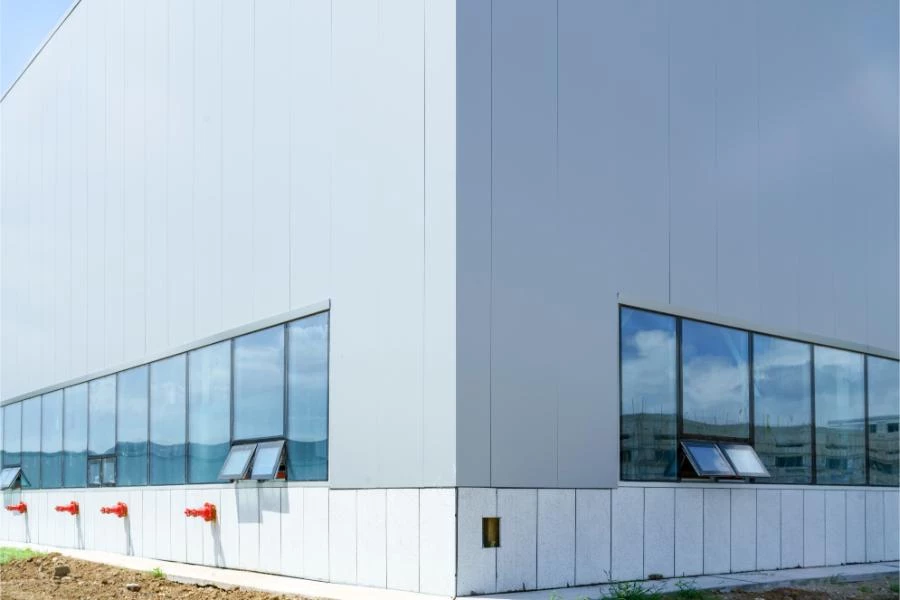
Cladding Cleaning in Shropshire
Get in touchAt Drone Cleaning, we specialise in professional cladding cleaning services in Shropshire WV16 4.
Our cladding cleaning services aim to maintain building exteriors, protect property investments, and enhance building aesthetics.
We use advanced drone technology for efficient, safe, and thorough exterior surface cleaning, allowing us to easily reach high-rise buildings, commercial properties, and residential structures.
Our professional team removes pollutants, grime, and organic growth that affect cladding, restoring and preserving its condition while helping extend the lifespan of building materials.
With our expertise, we provide effective, eco-friendly solutions tailored to each property's unique needs.
What Is Cladding Cleaning,?
Cladding cleaning is essential for maintaining a building's protective exterior layers and removing dirt, algae, pollutants, and residues that may weaken or corrode materials over time.
Dirt accumulation can trap moisture and, in turn, lead to mould and rot, especially on porous surfaces.
By removing these elements, cladding cleaning preserves the cladding’s protective functionality, ensuring it effectively shields the building against environmental factors like UV rays, rain, and pollution.
For businesses, regularly cleaned cladding can also reflect positively on brand image, providing an inviting, professional appearance.
What Types of Cladding Can Be Professionally Cleaned?
Professional cladding cleaning services can safely handle various materials, each with specific cleaning needs:
Metal cladding: requires regular cleaning to avoid rust and corrosion from air pollutants, especially in industrial or coastal areas.
Glass Cladding: demands streak-free methods to maintain transparency and a professional look, often using non-abrasive cleaners.
Stone Cladding: needs gentle, pH-neutral cleaners to prevent erosion or chemical reactions that can damage natural stone textures.
Composite and UPVC Cladding: These durable options resist some contaminants but may stain if neglected. Mild, eco-friendly detergents are typically used.
Wood Cladding: requires special care, often using low-pressure washing to avoid water penetration that could cause swelling or warping.
How Much Does Professional Cladding Cleaning Cost in Shropshire?
Cladding cleaning costs range from £5 to £20 per square metre in Shropshire, with additional charges for buildings with challenging access requirements or intricate designs.
Professional cladding cleaning costs vary widely based on building size, cladding type, and cleaning method.
What Are the Benefits of Regular Cladding Cleaning?
Routine cladding cleaning benefits both the aesthetic and functional aspects of a building.
Prolonged Durability – Removes corrosive materials like pollutants and salts, extending the lifespan of cladding.
Reduced Repair Costs – Prevents the need for frequent repairs, lowering long-term maintenance expenses.
Enhanced Energy Efficiency – Clean cladding reflects more sunlight, reducing heat absorption, which can lower cooling costs in warmer months.
Higher Property Value – Buildings with clean, maintained exteriors are perceived as more valuable and appealing in the real estate market.
How Often Should Cladding Be Cleaned?
The recommended cleaning frequency varies by location and material. For high-traffic, urban, or industrial areas, twice-yearly cleaning can mitigate the rapid buildup of pollutants.
Coastal areas may also need semi-annual cleaning to combat salt and moisture exposure.
More protected buildings, away from urban centres, may only require an annual clean to remain in optimal condition. Regular cleaning also aligns with many insurance policies, which may mandate specific maintenance intervals.
Can Cladding Cleaning Improve the Building’s Appearance and Value?
Professional cladding cleaning not only improves appearance but can also increase property value.
Buildings with well-maintained exteriors create a positive impression, influencing perceptions among tenants, customers, or buyers. This upkeep signals good property management, attracting higher rental rates or purchase offers.
In competitive property markets, clean cladding may provide a distinct advantage, making the property more appealing.
What Types of Cleaning Methods Are Used for Different Cladding Materials?
Professional cleaning services use tailored methods depending on the cladding material and soiling level:
Pressure Washing – Effective for durable surfaces but may damage softer materials if not carefully managed.
Soft Washing – Uses a mix of gentle detergents and low-pressure water to clean delicate cladding like wood and composite safely.
Steam Cleaning – Provides a high-temperature solution for removing stubborn contaminants, suitable for surfaces that can handle heat, such as stone and some metals.
Each method is chosen to maximise cleaning effectiveness while protecting the structural integrity of the material.
Are There Risks Associated with DIY Cladding Cleaning?
DIY cladding cleaning poses several risks, mainly due to the specialised equipment, chemicals, and safety protocols required for high or hard-to-reach cladding. Common risks include:
Surface Damage – Using incorrect cleaning agents or high-pressure methods can erode or stain certain materials.
Safety Hazards – Lack of professional access equipment increases fall risks, especially on tall structures.
Environmental Harm – Inappropriate detergents or improper rinsing can lead to runoff pollution. Professional services typically use eco-friendly methods, which are safer for surrounding landscaping and water sources.
Are Special Permits Needed for Cladding Cleaning on High-Rise Buildings?
High-rise cladding cleaning may require permits, especially when using drones or other aerial equipment. Drones are subject to strict regulations by the Civil Aviation Authority (CAA) in the UK, requiring permits for specific areas and heights.
Special permission may be needed if the building is in a densely populated area or close to sensitive locations like airports. Professional cleaning companies will manage these requirements, ensuring legal compliance before beginning the cleaning project.
How Can Cladding Cleaning Contribute to Sustainable Building Maintenance?
Regular cladding cleaning contributes to sustainability by extending the life of building materials, thus reducing the need for replacements and cutting down on waste. Furthermore, many cleaning services now use biodegradable, eco-friendly detergents and water-conserving methods like drones, which significantly reduce resource usage. Clean cladding also improves building insulation and can contribute to energy efficiency, ultimately lowering a building’s carbon footprint.
We cover Shropshire
